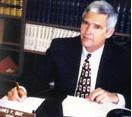As my father told the story, when he asked my mother to marry him, the only condition was that if they had a son they would name him after his younger brother Jim. I guess mom agreed, because that is what happened.
My uncle, James L Gray, was a special and unique man. He was a natural gymnast, golfer, skier and windsurfer, and also a natural leader. After graduation from UC Berkeley, and flying fighter airplanes out of Pensacola, Fla., during the Korean War, he returned to his native Southern California, bought a small house on Lido Island and sold heavy construction equipment for Hal Anawalt.
But one day he met a restaurateur named John McIntosh, the owner of the Snackshop and Coco's Restaurants, who wanted to open a steak house. Because of Jim's people and entrepreneurial skills, McIntosh asked him if he would be interested in being his partner. McIntosh already was highly knowledgeable in the food part of the business, so it became Jim's responsibility to learn and then oversee the bar and entertainment facets.
One evening as these plans were progressing, Jim was having dinner at our home in La Cañada and talking about what they were going to name their new restaurant. We had a great time discussing the possibilities. But eventually they settled upon John McIntosh's middle name, which was Reuben. And so the restaurant became known as Reuben's.
I went to the grand opening of the original Reuben's, which was on Coast Highway in Newport Beach at the present location of the Sol Restaurant. It became so successful that, with time, they opened more. So I also went to the grand opening of the Reuben's in Santa Ana, which became popular with many people in the area, including attorneys who worked at the courthouse.
Later they opened a Chinese restaurant next to the original Reuben's, which was called Wu Ben's. Unfortunately, even though the restaurant was successful, Jim said that the labor in providing quality Chinese food was disproportionate to their ability to get a proper return on their invested capital.
So they closed Wu Ben's and opened the first real nightclub in the area, which they called Isadora's. It was so successful that there was always a line of people waiting to get in. When I was in law school in 1971, Jim invited me to take a date to the Reuben E. Lee, and after dinner to go to Isadora's. But to avoid the line, Jim told me to go to the back door and tell them that I was his guest. So that is what we did. Of course, the manager didn't believe me when I said my name was Jim Gray, but after showing him my driver's license and him making a phone call, they put another table out for us. We had a great time.
The band, the Road Home, played there for years, and it was so good that people went crazy. Even so, when they announced their last number and asked people not to dance on the tables, I thought they were exaggerating. But they weren't because, but for that request, I probably would have been dancing on the tables along with most everyone else!
McIntosh and my uncle also opened the Gorda Liz on Bayside Drive, where the Bayside Restaurant now sits. This was a Portuguese-themed restaurant, and it was the most authentic, non-authentic restaurant I have even seen. One day Jim took us there for dinner, and requested we help him by ordering and trying every appetizer on the menu to see if each was satisfactory. It was my pleasure to help him out.
Eventually, Reuben's had restaurants nationwide, and they were so successful that they caught the attention of the Grace Lines Corp., which bought them out. Unfortunately, Grace Lines was too large an operation to devote the special care necessary for the continued success of a restaurant chain. So as the restaurants failed to keep up with the changing times, they slowly went out of business.
When things were going well, Jim traveled in some pretty big social circles, hanging out with George Argyros, Jim Gianulias and other highly successful people. But after he sold his stock to Grace Lines, Jim faced a weaker economy which caused him some problems in his later business ventures. Nevertheless, when he died in 2004, just shy of his 80th birthday, he still had a large turnout of friends and admirers at his memorial service. Fittingly the reception was one of the last functions at the Reuben E. Lee, which was then serving as the Newport Harbor Nautical Museum, before it was dismantled.
Why was Jim still so popular? Because to have friends, one must be a friend. And that is what Uncle Jim was all his life. One of his traits was that he treated everyone the same.
As just one example, he treated his stepchildren exactly the same as his biological children, even in his inheritance. During his life Jim had two wives, and after those marriages ended in a divorce, he also had two girlfriends. And each of those four women was actually present at his memorial service. Who else that you have ever known could make such a claim? Only my Uncle Jim, and I salute him.
JAMES P. GRAY is a retired judge of the Orange County Superior Court, the composer of the musical revue "Americans All," which will be performed in September and October at Vanguard University, and can be reached atJimPGray@sbcglobal.net.


+a.jpg)

